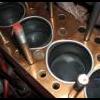
cleaning bolts?
#1

Posted 24 March 2007 - 10:22 PM
tar!
#2

Posted 24 March 2007 - 10:28 PM
otherwise de-greasent, effort and wire brush
#3

Posted 24 March 2007 - 11:46 PM
#4

Posted 24 March 2007 - 11:47 PM
#5

Posted 25 March 2007 - 02:24 AM
The electrode should be large (within reason), if possible, larger than the object being cleaned. The iron electrode works best if it "surrounds" the object to be cleaned. An iron electrode will be eaten away with time. Stainless steel has the advantage (also some alloys, but not all) in that it is not eaten away. I use an old kitchen sink in the garage (also used as a parts washer...), but I **REALLY** don't recomend trying this with a GOOD kitchen sink (can leave some stains....).
if you don't have an old sink to use, just place a large flat iron / steel etc, metal sheet in the base of the tub (or folded to fit the plastic tub if possible). Have also used an old (cleaned out to bare metal) paint can (steel).
Dip the objects to be cleaned in the solution / sink / tub / whatever, and make SURE the objects do NOT TOUCH the other electrode (metal sheet, sink etc) or you will SHORT OUT the charger!
Connect the battery charger, (or an old charged up car battery, if no charger) THE POLARITY IS IMPORTANT!! The iron or stainless electrode is connected to the positive (red / +) terminal. The object being cleaned, to the negative(black / - ). Make sure you have good contact, which can be difficult with heavily rusted objects. Get the connections backwards and your object will be relentlessly dissolved away! Make connections on a part of your electrode that is out of the solution, or your clamps / crocodile clips / whatever, will erode rapidly (then turn over when clean and connect otherway round to clean the rest). For bolts you can just use bare cooper wire and wrap a few turns around each bolt (so it looks like string of xmas lights), and use the wire to support the bolts in the solution.
If you want to do multiple objects (or bolts in this case) just connect them all together in series (with a smalll gap between them) and connect to the negative terminal.
When you switch on the battery charger the meter might show a slight current flowing, or if no meter or using a car battery just wait a few mins to see if very fine stream of bubbles (fizzing) forms around ALL of the bolts (if not check connections).
Then just leave it for a few hours if light to medium rust, or overnight for HEAVY rust. any flaky rust can just be scrubbed off. if a little rust remains after flaky rust as been removed, give it another blast in the solution for a couple more hours, and you will see bare clean metal.
You can use the solution over and over until it's full of crud.
Best part of this method is that it DOES NOT REMOVE metal from the object being cleaned, it just coverts the rust ( which can be important for things like bolts, nuts, screws etc). It also get to ALL the areas that wire brushing might not reach.
SS
#6

Posted 25 March 2007 - 07:29 AM
Now that sounds a plan.
Got any for an ultra sonic hot parts washer by any chance?
#7

Posted 25 March 2007 - 09:30 AM
#8

Posted 25 March 2007 - 09:38 AM
#9

Posted 25 March 2007 - 06:53 PM
SS
Now that sounds a plan.
Got any for an ultra sonic hot parts washer by any chance?
Actually, I could prolly run something up without too much effort. Would need to find a suitable sorce of ultrasonic transducers strong enough to cause cavitation.
Could prolly make a fairly cheap hand held "probe" that could be used in a modified parts washer though.........Hmmm, now there's an idea!
Might want to be carefull on ally parts though, I have heard some people say "don't use it on aluminium", supposedly they're bad for aluminium parts because of hydrogen embrittlement. Plenty of ally parts are put through them with out much harm, but I've never been able to find any "proof" one way or the other. Personaly I think it's prolly OK, I doubt the fast forming surface oxide layer will be disturbed, and it's the oxide that protects aluminium in the first place. Your milage may vary, don't blame me, etc.
SS
#10

Posted 25 March 2007 - 07:16 PM
If you used the same process on alloy parts, then put them in a pan of boiling water with a food colouring for 30 mins.SS
Now that sounds a plan.
Got any for an ultra sonic hot parts washer by any chance?
Actually, I could prolly run something up without too much effort. Would need to find a suitable sorce of ultrasonic transducers strong enough to cause cavitation.
Could prolly make a fairly cheap hand held "probe" that could be used in a modified parts washer though.........Hmmm, now there's an idea!still quite pricey though, high power ultrasonic transducers and generators are not cheap.
Might want to be carefull on ally parts though, I have heard some people say "don't use it on aluminium", supposedly they're bad for aluminium parts because of hydrogen embrittlement. Plenty of ally parts are put through them with out much harm, but I've never been able to find any "proof" one way or the other. Personaly I think it's prolly OK, I doubt the fast forming surface oxide layer will be disturbed, and it's the oxide that protects aluminium in the first place. Your milage may vary, don't blame me, etc.
SS
Would they be anodised then? Its a long time since I done chemistry.
#11

Posted 26 March 2007 - 01:04 AM
If you used the same process on alloy parts, then put them in a pan of boiling water with a food colouring for 30 mins.
Would they be anodised then? Its a long time since I done chemistry.
It's a similar sort of process, different chemicals involved, but same method - only in REVERSE.
Anodizing aluminium means that you are converting the VERY thin, weak aluminium oxide (which forms a natural barrier on bare ally metal - it's a VERY reactive metal) into a MUCH thicker coating that is very hard. To do this you just accelerate the natural formation of the oxide by connecting the aluminium part up to the POSITVE (anode - hence ANODizing...) which causes the oxygen to be striped from the electrolyte and react with the ally to form ally oxide.
The oxide layer is very porus on "type 2" anodized ally (sulphuric acid electrolyte at room temp ~ 20 deg C) and this allows the dyes to leach into the surface. Hotter acid temps (about 50 dec C or more) cause a thick, grey matt finish to the ally part, but can also cause pitting of the surface.
Food colouring will work, but it's not very good (tends to be very faded, not much resistance to UV light, so fades even more) Red food colouring gives a sort of see-through pink tint, blue gives a blueish "hard steel" sort of colour. You will prolly have better results using something like fabric dyes that are "UV fast", some inks, proper anodizing dyes or inorganic mineral dyes. Most of the organic dyes WILL change colour over time as they are affected by UV light (sunlight, halogen lights, etc), but fabric dyes will be longer lasting than most food dyes (much deeper colours too).
If you want to do it, it needs the same sort of set up, plastic tub (must be plastic due to acid), battery charger and fair amount of sulphuric acid (or sulfuric as it's also called), and some lead or alloy metal sheet (lead is better). The ally part is hooked the positive (+) of the charger and the negative to some Lead sheets either side of the tub. You can get lead sheet from any builders merchant (or church roof...)
The best way to connect the current to the part to be anodized, is use aluminium wire and bend it to make a hook, then hook the part on and dip into the solution and connect the wire to the battery charger. Should be able to get thin ally wire from welding supliers, builders mechants etc.
The electrolyte is 15 - 20% Sulphuric acid mixed with water. ALWAYS add acid to water, NEVER ADD WATER TO ACID!! Otherwise it could cause a reaction and boil over. Quite a bit of heat is produced when adding the acid, so be carefull. AND WEAR EYE PROTECTION!
You can get acid from a CHARGED car battery (a flat battery is mostly water), as the battery acid is already mixed with some water, just add a 50 :50 mix of acid to water and this should give about a 20% solution. You can also get acid from chemistry lab supplies, many places on the web, or even the local motor factors (for car batteries).
How long it take to complete, depends on the temperature of the electrolyte, current / voltage settings, and the size of the part. Once tha part is removed from the bath, rinse the acid off with COLD water. You can then go on to add a dye to the part.
There are a ton of websites related to DIY anodising, just google it, should pull up loads of resources.
SS
#12

Posted 26 March 2007 - 04:23 AM
Cheers
#13

Posted 26 March 2007 - 05:27 AM
#14

Posted 26 March 2007 - 06:04 AM
#15

Posted 26 March 2007 - 07:12 AM
1 user(s) are reading this topic
0 members, 1 guests, 0 anonymous users























